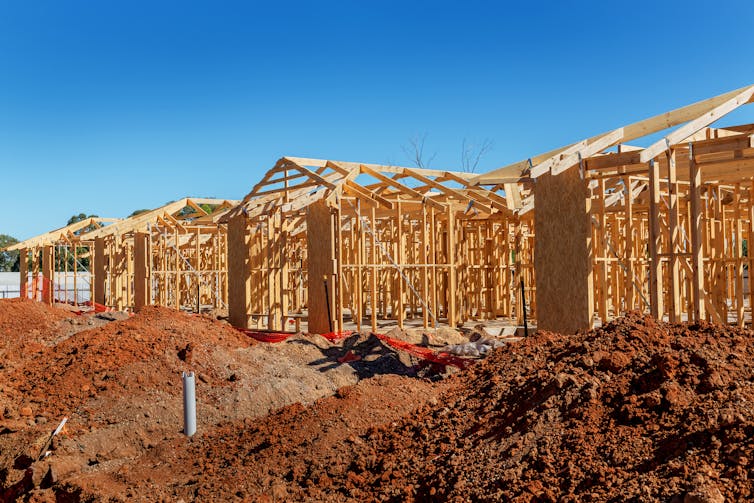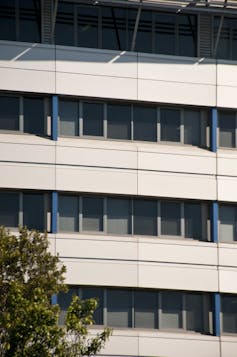Why the focus of stimulus plans has to be construction that puts social housing first
- Written by Geoff Hanmer, Adjunct Professor of Architecture, University of Adelaide
Australia has done better with COVID-19 than anyone dared hope. This opens up the prospect of a progressive relaxation of restrictions later this year. Organisations that could participate in an economic stimulus program will need to be in a position then to deliver “shovel-ready” projects to help revive the economy.
The construction sector is the obvious focus of a stimulus plan, and the construction of social housing should be the priority, for reasons that I’ll outline below.
Read more: Is social housing essential infrastructure? How we think about it does matter
The Rudd government’s stimulus package during the Global Financial Crisis gives us a helpful guide to what does and doesn’t work. The initiatives that failed did so because of a lack of proper planning.
Fortunately, if we get going now, we have months to plan the recovery program. Getting it right will be crucial. By September, one month before JobKeeper payments end, many businesses are going to be on their knees.
Why construction?
Most of the successful elements of the Rudd package focused on construction. The reason is simple. Nearly one in ten Australians work in the construction industry. Many more are employed locally in the production of building products.
Both construction and building product manufacturing provide jobs for people with varying levels of skill, including people who are unskilled. The vast majority of concrete and steel reinforcement, bricks, wall framing, building boards, windows and doors, roof tiles and metal cladding are still made here. A substantial portion of domestic electrical and plumbing products, including stainless steel sinks, copper pipes and electrical cables are also made here.
It’s important to realise that the type of building being constructed will affect its local stimulatory impact. For buildings up to three storeys high, over 50% of their cost is labour on site. Of the remaining cost, the vast majority is Australian-made materials and components. (Although the Australian Bureau of Statistics stopped its series on Australian-made construction products in 2014, the employment impact can still be estimated from ABS manufacturing statistics.)
 For typical single and double-storey housing, more than half the cost goes into labour and locally made materials account for most of the rest of it.
Shutterstock
For typical single and double-storey housing, more than half the cost goes into labour and locally made materials account for most of the rest of it.
Shutterstock
However, the taller a building gets, the greater the percentage of imported components – lifts, mechanical components and facade systems are mostly imported.
Why social housing?
What sort of construction projects should the government consider for a stimulus package? While the response so far has been to focus on “fast-tracking” infrastructure, the current crisis has highlighted a number of pressing social needs. Various aspects of social housing top the list:
Housing to reduce the number of people living in precarious private rentals. A substantial program to increase the stock of social housing would be a great legacy.
Housing for people who are homeless. They will not be able to go on living in hotels once the lockdown ends.
Affordable housing for workers in health, emergency services, education and retail who cannot afford to live close to the communities they provide vital support to. It turns out they are essential workers, some of the most important people in Australia, so we need to look after them.
Housing construction is a very effective way to create jobs, both directly and downstream. About 6% of Australian jobs are related to housing.
What other construction work is needed?
There are other opportunities for well-targeted construction stimulus.
 Replacing combustible cladding is another essential, labour-intensive program that could stimulate the economy.
STR/AAP
Replacing combustible cladding is another essential, labour-intensive program that could stimulate the economy.
STR/AAP
In many areas of Australia, public schools and kindergartens still rely on low-quality portable buildings or buildings that have exceeded their economic life. A program to replace them with new and efficient buildings would produce substantial social benefits, cut maintenance costs and improve sustainability.
Improving the deteriorated state of community buildings and parks, particularly in disadvantaged areas, would also deliver social benefits and potentially employ a lot of unskilled labour. Having decent parks and exercise facilities close to where people live will allow social distancing to continue as long as needed.
A Victorian government plan to remove combustible cladding from residential and community buildings could also be extended to all states. It’s essential work that would also create jobs.
Read more: Flammable cladding costs could approach billions for building owners if authorities dither
The government could also consider a program to replace or refurbish university teaching and research buildings that are over 40 years old. Incredibly, as we have found at ARINA in our consultancy work, these older buildings still provide more than half of the 11.8 million square metres of gross floor space occupied by the higher education sector.
These ageing buildings are not well suited to supporting the research into solutions to SARS-CoV-2 and other pressing medical and economic problems. Replacing or refurbishing them would improve outputs, cut maintenance costs and improve sustainability, plus give a much-needed boost to the higher education sector.
Plan now to be shovel-ready
Anglicare SA is already thinking of what it can do to deliver more social housing. Its CEO, Peter Sandeman, told me he is making sure Anglicare has “shovel-ready projects that can be rolled out the moment a stimulus package is announced. There is no better way of stimulating the economy than by constructing social housing.”
This is stimulus that also meets critical social needs, Sandeman says.
There is a desperate shortage of social housing. Our waiting list and the number of people who are homeless demonstrates that.
Social housing provides a long-term benefit to everyone. It adds stability to the lives of the occupants and this is a particular benefit to their children and their education. Safe, affordable housing is the foundation stone that gives people a chance in life.
Other organisations that could be part of the stimulus package should be getting ready, too, and making sure the government knows what they are doing.
Read more: Australia's housing system needs a big shake-up: here's how we can crack this
Authors: Geoff Hanmer, Adjunct Professor of Architecture, University of Adelaide





